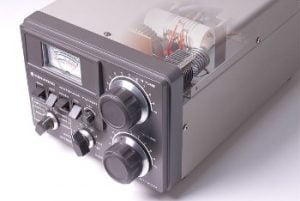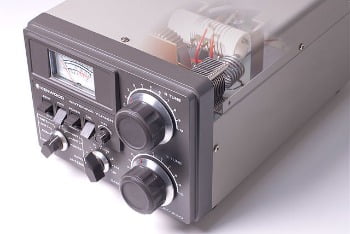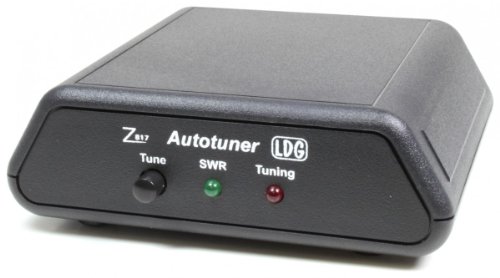With the best antenna tuner, making the antenna match the feeder and reduce the SWR is a breeze.
This device is precise and reliable, providing quick results in mere seconds. Of course, not every tuner can get the job done, and that’s when this article comes into play.
The reviews below will help you find only the most capable antenna tuners out there.
Before going any deeper, let’s first answer two common questions about antenna tuners.
Best Antenna Tuner Comparison Table of 2025 (Updated)
| Brand Name | Detail |
|---|---|
| ICOM AH4 13 | |
| MFJ MFJ-945E | |
| ICOM AT-130 | |
| LDG Electronics IT-100 | |
| ICOM AT-140 | |
| Palstar HF-AUTO | |
| MFJ-941E | |
| LDG Electronics Z-817 |
What is The Best Antenna Tuner?
With a wide tuning range and an automatic system, the ICOM AH4 13 Tuner is the best of its kind.
Operating it is as easy as pushing a button, making it an intuitive device to use. Plus, the unit’s weather-proof build allows it to fit well in any location.
Furthermore, this particular tuner is super versatile. It works well with standard ICOM radios but also with dipoles, loops, and more.
The ICOM AH4 13 is an all-around tuner that meets most demands by far. Plus, for the price, it’s a tuner that none can’t ignore.
Why is ICOM The Best Brand of Antenna Tuners?
ICOM has been an established brand for many years. They specialize in producing land, sea, and air equipment.
Suffice to say the company excels in every one of those areas. Clear evidence of their quality products is that this list features not only one but several IMCO antenna tuners.
These tuners are ideal for IMCO equipment, delivering precise and fast tuning.
Since the instructions are clear, the units are easy to figure out and understand. Doing so guarantees proper use of the tuner, which means better results.
What to Consider When Buying Antenna Tuners
Knowing the following features will help you find the best antenna tuner. Here’s what you need to know before picking an antenna tuner.
Frequency Covered
The frequency range is what determines the capabilities of an antenna tuner. It’s also a good indicator of the tuner’s limitations.
As seen during the reviews, units like the MFJ-945E work within a 1.8-60MHz range. That’s one of the highest.
Checking whether the unit covers the band needed for your applications is a must.
Often, the tuners cover HF bands from 160 meters to 10 meters. Other options cover 80 meters to 10 meters.
Lesser tuners have coverage from 6 meters, too.
Automatic or Manual
Antenna tubers have either automatic operations or by hand. Manual units have control knobs and several switches.
Automatic tuners are more intuitive and don’t need as much involvement as manual devices.
There’s no doubt that the best automatic antenna tuner makes everything easier. Still, manual antenna tuners are capable as well.
It all boils down to which one you prefer.
Memory
Automatic antenna tuners have memories, and they can save settings of frequencies tuned.
The memories often save up to 2,000 frequencies, meaning there’s no need to channel them once again later on.
Housing
The tuner’s housing is also an important feature to consider. Antenna tuners come in aluminum or metal cases with high resistance.
Even under rough weather conditions, these units hold on well.
Low Power Operation
The tuner can achieve better performance by emitting low power output.
During tuning, a low power tune-up means less interference with other stations. Frequency readings are faster, and the results improve by a lot.
Easy to Install & Use
Finally, make sure the tuner you buy has proper instructions available.
Otherwise, both installing and using the device will be troublesome. A unit with proper guidelines is always better. More so if you’re looking for the best remote antenna tuner.
8 Best Antenna Tuners Reviews in 2025
The next products are the top ten antenna tuners. These units delivered super-fast tuning in wide frequency ranges.
Because of that, they put up a reliable performance with high precision as well. Want to know more? Then don’t miss out on these tuners!
01. ICOM AH4 13 Auto Tuner – Best Overall

Highlighted Features
- Wide Tuning Range
- Automatic Digital Control Tuning
- Frequency Memory
- Weather-proof Design
This unit can tune 80 to 6 meters without glitches, offering an improved system for quick tuning.
Besides matching a vast range of impedance, the tuner doesn’t suffer interferences.
Whether it is under humidity, heat, rain, or snow, the device puts up with all conditions.
Setting up the tuner is quick. The instructions are clear and easy to follow.
All it takes is to plug the control cable, connect the AH4 into the transmitter’s RF1 output, and that’s it.
A no-brainer process that gets the tuner up and going in a few seconds.
“One issue this tuner has is the gasket, which is delicate. Keeping it in place is tricky during the assembly if you’re mounting a vertical.”
The tuner makes for a perfect interface with ICOM rigs, making it essential for ICOM users.
Of course, the tuner is capable of more than that. It performs well with dipoles and loops as well.
Without a doubt, this unit is the best automatic antenna tuner.
What We Liked
- Using this unit is a no-brainer
- Perfect interface for ICOM rigs
- Works with dipoles & loops
- Perfect for random wire length antenna
What We Didn’t Like
- The delicate gasket is hard to keep in place
02. MF J-945E Antenna Tuner – Best Manual Antenna Tuner

Highlighted Features
- 8x2x6-Inch Size
- 8-60MHz Range
- Cross-Needle Meter
- Antenna, Transceiver inputs
- Manual Tuning Controls
With an 8x2x6-inch size, this device is small and compact. It puts up with 300 Watts, and it has a front panel with several functions to use.
For instance, there are three knobs to control the antenna, transmitter, and inductance.
Near the center, there’s a display with meters that offers accurate readings.
The meters illuminate when connected to a 12Vdc.
The unit features a straightforward design. At the back, it has SO-239 inputs for antenna and transceivers.
The frequency picked varies from 1.8 to 60 MHz, with 6 thru 160 meters capacity.
You can use this tuner for Ham Radio, CB, and HF.
Like other MFJ tuners, this one also comes with a cross-needle meter.
It’s a useful power meter function within 300W and 30W scales.
“Mastering this tuner does take some time, but it’s worth it. For the money, there’s no alternative as good as this one.”
Due to its portable design, you can use this tuner at a fixed location or as a mobile tuner.
Since it covers all HF bands and 6m bands, the unit can tune almost anything.
The directions may be confusing at first, but you get the hang of this antenna tuner in due time.
For the price, the MFJ-945E is the best manual antenna tuner.
What We Liked
- Many functions in a compact unit
- Perfect as mobile or fixated tuner
- High-frequency coverage
- Super accurate meters
What We Didn’t Like
- Directions aren’t clear at first
03. ICOM AT-130 Automatic SSB Antenna Tuner – Most Resistant

Highlighted Features
- Low Power Tune-Up
- Preset Tuning Function
- Waterproof enclosure
- Automatic Tuning
This tuner can match SSB transceivers to a long wire antenna with less insertion loss.
While tuning, it emits low output power. That’s a benefit for many reasons, one of which is because it reduces interference risks.
Additionally, the device has a preset tuning function for faster tuning later on.
Like other ICOM tuners, this one is easy to install as well. By connecting the control cables and short-time internal settings, the unit is ready to go.
What’s even better is that no maintenance is necessary afterward.
This unit is suitable for ICOM SSB radios, and it can match radio to antenna impedance for practical use.
The tuner comes with lengthy manual offering instructions for almost everything.
From installation to tips on how to use the tuner best, the guidelines are excellent.
“But the manual still lacks some information. It doesn’t have clear guidelines about matching the tuner with anything other than an ICOM HF set.”
For M-700 SSB Radio, the tuner offers excellent results. It has a quick tuning system that takes about two seconds to pick new frequencies.
This unit also has a memory to save frequencies, and it takes less than a second to tune those.
What We Liked
- Finds frequencies in seconds
- Excellent for a balanced antenna
- Detailed guidelines for different applications
- Memory for faster tuning
What We Didn’t Like
- Lacks instructions for non-ICOM rigs
04. LDG Electronics IT-100 Antenna Tuner – Easiest to Use

Highlighted Features
- 8-54.0 MHz Coverage
- 2,000 Memories
- 14-Inch ICOM Radio Interface
- Tuner Button / Push Button
At 1.5 pounds and a 6.5 by 6.5 and 1.25-inch size, this unit is compact and lightweight.
It’s a convenient antenna tuner with frequency coverage from 1.8 to 54.0 MHz.
Plus, it comes with a built-in frequency sensor that provides precise readings.
Compatible with AH-4 or AH-3 ICOM models, the tuner offers versatility and quick tuning.
There are two methods to control this device. First, you can do it from the ICOM Tuner button after establishing the connection.
An alternative to that is using the tuner push-button on the tuner. Either way, both methods trigger the tuning system to start the operation.
Considering the tuner comes with the ICOM interface cable, it’s pretty much ready to use out of the box.
This tuner is an automatic device, so there’s no need to do much to make it work.
Pressing the button is all you have to do, and then let the tuner do the rest.
It can reduce power, match the antenna to the gig, and restore original power.
Also, the 2,000 location memories provide instant frequency tuning.
“One minor nitpick about this tuner is that it only runs at 30-35 Watts on digital mode.
It doesn’t take anything away from the performance of the unit, but it’s a significant observation still.”
What We Liked
- Comes assembled, ready to use
- Doesn’t need an extra power supply
- Operating the tuner is a breeze
- Small, compact, and lightweight
What We Didn’t Like
- 30 Watts limit on digital
05. ICOM AT-140 SSB Antenna Tuner – Best Memory Capacity

Highlighted Features
- ASA Case & Rubber Gasket
- Wide HF Marine Band Coverage
- Full Automatic Tuning
- 45 Memories
- Super Capacitor
Housed in a resistant ASA case with rubber gaskets, this tuner is durable and resistant.
It’s a weather-proof build that withstands the toughest conditions.
Because of that, you can set it up on the deck or near the antenna.
In either case, the installation is simple: connect the control antenna cable, and that’s it! There’s no need to open the cover.
The ICOM AT-140 matches any frequency on every HF marine band.
For instance, it can match a 23 feet long wire antenna over 1.6-30MHz.
Doing that is hassle-free, as the unit comes with an automatic tuning system.
Push the tune button, and the tuner adapts to the minimum SWR of any frequency.
This tuner also allows HF operation in locations with limited space for the antenna.
While active, the device has 45 memories to remember the most-used frequencies.
For later use, re-tuning those frequencies takes only a few seconds.
Additionally, the supercapacitor has memory backup. Even if the tuner remains unused for days, it’ll still back up the memory’s content.
“The manual is great, but it lacks some essential information. For example, the instructions aren’t clear if you’re using the tuner for anything other than an ICOM HF set.”
What We Liked
- Fantastic rugged build
- Easy installation is a no-brainer
- Effective memory backup
- Ideal for ICOM radios
What We Didn’t Like
- Lacks extended, detailed instructions
06. Palstar HF-AUTO Automatic Antenna Tuner – Most Powerful

Highlighted Features
- 8-54 MHz Coverage
- 1,800 Watts Capacity
- LCD screen
- High-speed processor
With 1,800 Watts of power rating, this tuner is among the most powerful. It covers 160 to 6 Meters and a frequency range of 1.8 to 54 MHz.
By featuring a high-speed processor, the tuning is accurate. The unit has a large LCD screen with a lit background and four lines of clear print to show RF power readings.
At first, tuning may take a while to find a proper match. But, once it picks up frequencies, the tuner does a good job memorizing them.
For later use, the tuning is instant. The device works well, without any issues at all.
With proper and detailed instructions, the unit is also easy to set up.
“Still, you must be careful while using the knob. It turns even with the slightest touch, so finding the right setting isn’t always easy.”
This unit is big, meaning more scape is necessary for its installation.
After setting it up, the tuner operates super quiet and smooth. There are three inputs available, offering a flexible system as well.
In general, this Palstar automatic antenna tuner is one of the most reliable out there.
What We Liked
- Super easy to operate
- Improved interface for easier readings
- Quiet and smooth performance
- Large and sturdy build
What We Didn’t Like
- The knob turns with the slightest touch
07. MFJ-941E HF Antenna Tuner – Best Calibrated

Highlighted Features
- Aluminum Cabinet
- Antenna Switch
- Cross-Needle Meter
- AirCore Inductor
The MFJ-941E is a 300 Watts tuner capable of covering from 1.8 to 30 MHz.
This device has useful features, like the cross-needle meter with an on/off switch.
Said meter displays data like SWR, forward, and the reflected power within 300/60 and 30/6 Watt ranges.
Plus, the tuner comes with an 8-position antenna switch.
This switch allows you to select between coax lines, wire/balanced lines, and even dummy load.
For the latter, it can be either direct or through. Also, the 12-position air wound inductor reduces losses while putting out more power.
“Yet, the meters are a bit small. Increasing their height and size would be an improvement.
Luckily, this is a mild inconvenience that doesn’t affect the unit’s accuracy.”
Since the calibration of the meters is top-notch, their small size isn’t an issue.
The device is resistant and durable due to its aluminum cabinet.
The front panel is intuitive, making the tuner easy to use. And, since each knob is responsive, operating this tuner is easy.
What We Liked
- Super easy to operate
- Provides accurate measurements
- Calibrated meters
- Scratch-proof build
What We Didn’t Like
- Meter size
08. LDG Electronics Z-817 Automatic Antenna Tuner – Smallest Tuner

Highlighted Features
- Advanced memory
- Interface-powered system
- Automatic operation
- Lightweight & Portable
By featuring a modern design, this tuner appeals to all audiences. It connects with transceivers via the CAT port, offering full control of the tuning cycle.
Plus, it includes a CAT cable to make it an integrated and interface-powered tuner. That means that installing and using this tuner is hassle-free.
This unit has an automatic system, and it only requires you to press a button to start the tuning cycle.
Here, the tuner can use its advanced memory to remember your favorite frequencies.
With 2,000 memory locations, no longer will you have to worry about losing frequencies.
The LDG Z-817 tuner has coverage from 1.8 to 54.0 MHz. It runs on four 1.5V AA batteries, with a capacity between 0.1 and 20 Watts.
Since it has latching relays, the device puts out an ultra-low-power performance.
Finally, the tuner’s compact and small design allows it to fit well in most locations.
“Operating this tuner is easy. Still, it may need you to press the tune button a few times before it picks up the radio frequencies.”
What We Liked
- Compact design
- Powered by batteries
- Channels frequencies fast
- No extra cables needed
What We Didn’t Like
- May need to press the tune button twice

Photo credit Wikipedia under C.C.
Conclusion
With any of the antenna tuners reviewed here, you can now say goodbye to your old tuner.
The devices on this list are top-notch. They provide accurate tuning, reliable automatic systems, and user-friendly interfaces.
Next time you’re thinking about the best antenna tuner, give one of these units a try.
They fit well in many applications, so you’ll find more than one purpose for them.
Similar Posts:
- 11 Best Marine TV Antenna Reviews in 2025 – Buying Guide
- Micropower Broadcasting: A Technical Primer (How to Start a Micro-Radio Station)
- 9 Best HF Vertical Antennas (Reviews 2025)
- 7 Best Antenna Rotator Reviews 2025 (Faster! Automatic Positioning)
- 9 Best Dipole Antenna of 2025 – A Comprehensive Buying Guide









